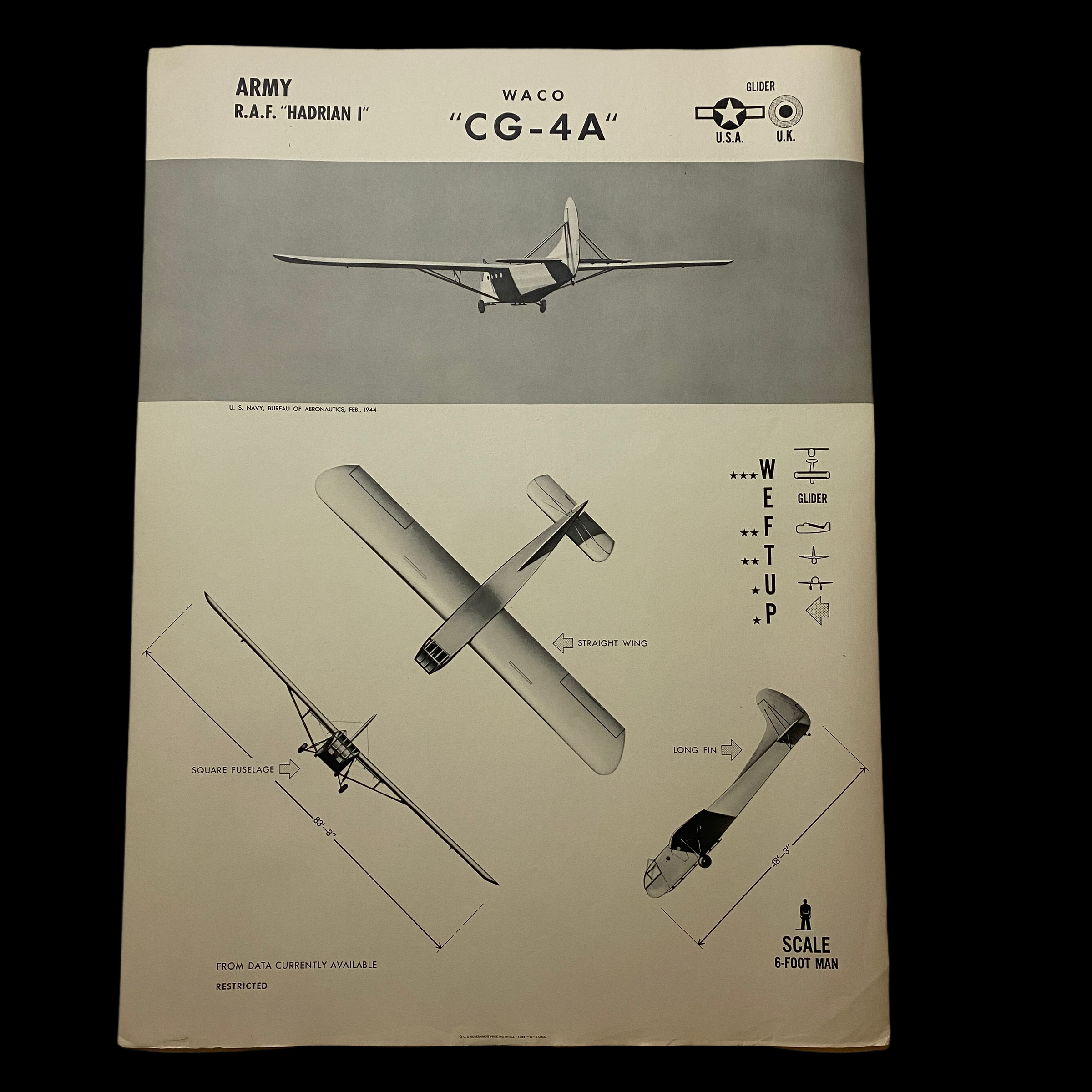WWII 1944 US Army (Airborne D-Day Normandy) Glider "Waco CG-4A" W.E.F.T.U.P. ID Poster






WWII 1944 US Army (Airborne D-Day Normandy) Glider "Waco CG-4A" W.E.F.T.U.P. ID Poster
Size: 19 x 25 inches
This original ‘RESTRICTED’ aircraft identification poster was published by the U.S. Naval Aviation Training Division Feb 1944. This poster was posted as a training tool as well as an in theater ID poster to help U.S. and other Allied pilots, bomber crews and Naval personal to identify Allied and enemy aircraft. W.E.F.T.U.P. or Wing, Engine, Fuselage, Tail, Undercarriage, Peculiarities was a system set up for the purpose of aircraft identification and recognition.
World War II saw some of the first introduction of these aircraft ID poster to prevent friendly fire and more accurate plane recognition in combat. It was believed these posters alone could save countless lives from friendly aircraft-on-aircraft or friendly anit-aircraft fire. These posters also could cut down precious second pilots, bomber gunners, and naval gun crews would have to ID a plane flying towards them intern saving their lives by shooting first.
Each poster provides the silhouettes, dimensions, and relevant information to educate both air and ground personnel in aircraft identification. Immediate identification of aircraft, friendly or not, was essential in order for the observer (whether in the air e.g., pilot, gunner, or patrol observer, or on the ground, e.g., anti-aircraft crew) to determine his next course of action (e.g., acknowledge, attack, evade, or report). Each poster details a large clean sky and background image of the specified aircraft located as the main top imagine on the poster. It also contains important ‘peculiarities’ such as where certain gun emplacements are located, other special aircraft features, as well as wing and length measurements.
The Waco CG-4 was the most widely used American troop/cargo military glider of World War II. It was designated the CG-4A by the United States Army Air Forces,[1] and given the service name Hadrian (after the Roman emperor) by the British.Designed by the Waco Aircraft Company, flight testing began in May 1942, and eventually more than 13,900 CG-4As were delivered.Sedalia Glider Base was originally activated on 6 August 1942. In November 1942 the installation became Sedalia Army Air Field, (after the war would be renamed Whiteman Air Force Base) and was assigned to the 12th Troop Carrier Command of the United States Army Air Forces. The field served as a training site for glider pilots and paratroopers. Assigned aircraft included the CG-4A glider, Curtiss C-46 Commando, and Douglas C-47 Skytrain. The C-46 was not used as a glider tug in combat, however, until Operation Plunder (the crossing of the Rhine) in March 1945.CG-4As went into operation in July 1943 during the Allied invasion of Sicily. They were flown 450 miles across the Mediterranean from North Africa for the night-time assaults such as Operation Ladbroke. Inexperience and poor conditions contributed to the heavy losses. They participated in the American airborne landings in Normandy on 6 June 1944, and in other important airborne operations in Europe and in the China Burma India Theater. Although not the intention of the Army Air Forces, gliders were generally considered expendable by high-ranking European theater officers and combat personnel and were abandoned or destroyed after landing. While equipment and methods for extracting flyable gliders were developed and delivered to Europe, half of that equipment was rendered unavailable by certain higher-ranked officers.[citation needed] Despite this lack of support for the recovery system, several gliders were recovered from Normandy and even more from Operation Market Garden in the Netherlands and Wesel, Germany.The CG-4A found favor where its small size was a benefit. The larger British Airspeed Horsa could carry more troopers (seating for 28 or a jeep or an anti-tank gun), and the British General Aircraft Hamilcar could carry 7 tons (enough for a light tank), but the CG-4A could land in smaller spaces. In addition, by using a fairly simple grapple system, an in-flight C-47 equipped with a tail hook and rope braking drum could "pick up" a CG-4A waiting on the ground.[10] The system was used in the 1945 high-elevation rescue of the survivors of the Gremlin Special 1945 crash, in a mountain valley of New Guinea.[11]The CG-4A was also used to send supplies to partisans in Yugoslavia.After World War II ended, most of the remaining CG-4As were declared surplus and almost all were sold. Many were bought for the wood in the large shipping boxes. Others were bought for conversion to towed camping homes with the wing and tail end cut off and being towed by the rear section and others sold for hunting cabins and lake side vacation cabins.The last known use of the CG-4A was in the early 1950s by the USAF with an Arctic detachment aiding scientific research. The CG-4As were used for getting personnel down to, and up from, floating ice floes, with the glider being towed out, released for landing, and then picked up later by the same type of aircraft, using the hook and line method developed during World War II. The only modification to the CG-4A was the fitting of wide skis in place of the landing gear for landing on the Arctic ice floes.